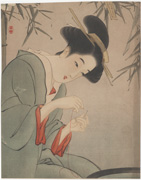Prints in Collection
Bijin threading a needle,
c. 1915-early 1920s
IHL Cat. #1793
Biographical Data
Biography
Migita Toshihide 右田年英 (1863-1925)
Sources: Guide to Modern Japanese Woodblock Prints: 1900-1975 by Helen Merritt and Nanako Yamada, University of Hawaii Press, 1992, p. 89; In Battle's Light: Woodblock Prints of Japan's Early Modern Wars, Elizabeth de Sabato Swinton, Worcester Art Museum, 1991, p. 60; Woodblock Kuchi-e Prints: Reflections of Meiji Culture, Helen Merritt and Nanako Yamada, University of Hawaii Press, 2000, p. 207; A Dictionary of Japanese Artists: Painting, Sculpture, Ceramics, Prints, Lacquer, Laurance P. Roberts, Weatherhill, 1976, p. 112.
Art names ("gō") include Toshihide 年英, Bansuirō 晩翠楼, Ichiesiai 一頴斎, Gosai 梧斎.
Migita Toshihide was born in 1863 with the name Migita Toyohiko 右田豊彦 in Ōitaken, Shizuoka Province. His father was a Kano school painter. He studied Western-style painting under Kunisawa Shinkuro (1847-1877) and after Shinkuro’s death with Honda Kinkichirō (1850?-1921), before entering the school of Tsukioka Yoshitoshi (1839-1892) in Tokyo at the age of 17, from whom he received his art name Toshihide. He studied Japanese-style painting with Watanabe Shotei (1851-1918) and it is reported that he studied ceramic decoration at some point in his life. He designed a wide variety of prints including actor prints, bijin-ga (prints of beautiful women), newspaper illustrations, kuchi-e (illustrations for novels) and senso-e of the Sino-Japanese (1894-1895) and Russo-Japanese (1904-1905) Wars. From 1887, like many of the woodblock artists who were trying to adapt to changes in art and publishing, he worked as an illustrator for books and newspapers, including a long stint with the Asahi shimbun starting in 1897. He was a member of the Nihon Bijutsu Kyokai (Japan Art Association) and Nihon Bijutsuin (Japan Art Institute), frequently serving as a juror for these groups. Among his pupils were Ikeda Terukata (1883-1921), Ikeda Shōen (1886-1917), Kaburagi Kiyokata (1878-1972) and Hirezaki Eihō (1881-1968).
While Toshihide is best known for his Sino-Japanese and Russo-Japanese War prints he produced some beautiful prints of bijin-ga such as Twelve Aspects of Beautiful Women (Bijin junishi), 1901 published by Akiyama Buemon.
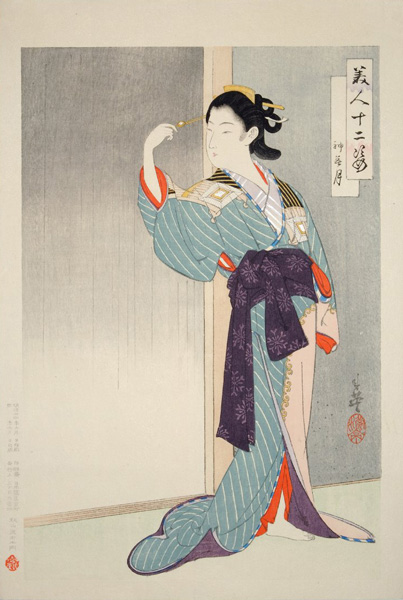 Kannazuki, Twelve Aspects of Beautiful Women, 1901 The British Museum 1906,1220,0.1518 | 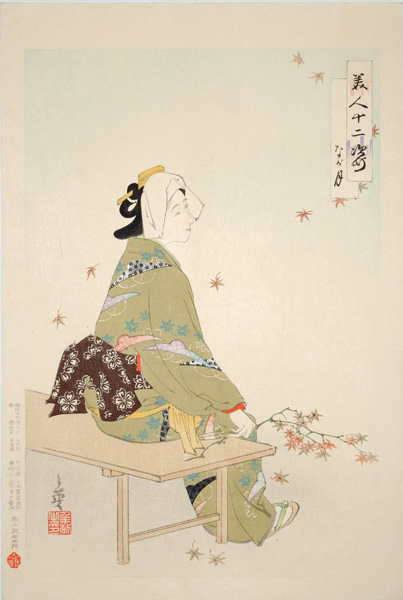 Nagatsuki, Twelve Aspects of Beautiful Women, 1901 The British Museum 1906,1220,0.1528 |
1 "Prints of the Sino-Japanese War," Donald Keene, Impressions of the Front: Woodcuts of the Sino-Japanese War, Shunpei Okamoto, Philadelphia Museum of Art, 1983, p. 9.
Samples of Seals and Signatures of Artist
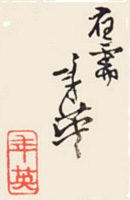 応需年英 / 年英 ōju Toshihide with Toshihide seal |  応需年英 / 年英 ōju Toshihide with Toshihide seal |  応需年英 / 年英 ōju Toshihide with Toshihide seal |  年英 / 梧斎 Toshihide with Gosai seal |  [right column unread] 年英 / ?梧斎 ? Gosai seal |  年英 / 梧斎 Toshihide with Gosai seal |  年英 Toshihide |
 応需梧斎 / 年英之印 ōju Gosai with Toshihide "no in" seal ("no in" - "seal of") |  応需梧斎 / 年英 ōju Gosai with Toshihide seal |  応需年英 / 年英 ōju Toshihide with Toshihide seal |  年英 / 年 英 Toshihide with toshi and hide seals | 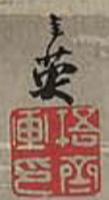 年英 / 梧斎画印 Toshihide with Gosai "ga in" seal |
last revision:
12/31/2018



